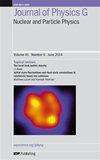稀释暖核系统中的等标化
IF 3.5
3区 物理与天体物理
Q2 PHYSICS, NUCLEAR
Journal of Physics G: Nuclear and Particle Physics
Pub Date : 2023-12-13
DOI:10.1088/1361-6471/ad0edd
引用次数: 0
摘要
重离子碰撞是探索低于饱和密度ρ0的热核物质的良好工具。已经证实,如果一个核系统达到了热平衡和化学平衡,那么在比较质子分数不同的两个系统时,就会产生同位素的等比例特性。本文介绍了对膨胀气源在探索不同热力学状态(密度、温度、质子分数)时的等比例特性的研究。这项实验工作强调了氢与 3He 和 4He 氦同位素之间存在等比例关系,这与热平衡和化学平衡的假设相吻合。此外,这项工作还揭示了当两个系统的总质量和温度略有不同时,等比例关系的局限性。此外,还观察到 6He 同位素存在差异,这可以用有限尺寸效应或该星团的特殊光环性质来解释。本文章由计算机程序翻译,如有差异,请以英文原文为准。
Isoscaling in dilute warm nuclear systems
Heavy-ion collisions are a good tool to explore hot nuclear matter below saturation density, ρ
0. It has been established that if a nuclear system reaches the thermal and chemical equilibrium, this leads to scaling properties in the isotope production when comparing two systems which differ in proton fraction. This article presents a study of the isoscaling properties of an expanding gas source exploring different thermodynamic states (density, temperature, proton fraction). This experimental work highlights the existence of an isoscaling relationship for hydrogen and 3He, 4He helium isotopes which agrees with the hypothesis of thermal and chemical equilibrium. Moreover, this work reveals the limitations of isoscaling when the two systems differ slightly in total mass and temperature. Also, a discrepancy has been observed for the 6He isotope, which could be explained by finite size effects or by the specific halo nature of this cluster.
求助全文
通过发布文献求助,成功后即可免费获取论文全文。
去求助
来源期刊
CiteScore
7.60
自引率
5.70%
发文量
105
审稿时长
1 months
期刊介绍:
Journal of Physics G: Nuclear and Particle Physics (JPhysG) publishes articles on theoretical and experimental topics in all areas of nuclear and particle physics, including nuclear and particle astrophysics. The journal welcomes submissions from any interface area between these fields.
All aspects of fundamental nuclear physics research, including:
nuclear forces and few-body systems;
nuclear structure and nuclear reactions;
rare decays and fundamental symmetries;
hadronic physics, lattice QCD;
heavy-ion physics;
hot and dense matter, QCD phase diagram.
All aspects of elementary particle physics research, including:
high-energy particle physics;
neutrino physics;
phenomenology and theory;
beyond standard model physics;
electroweak interactions;
fundamental symmetries.
All aspects of nuclear and particle astrophysics including:
nuclear physics of stars and stellar explosions;
nucleosynthesis;
nuclear equation of state;
astrophysical neutrino physics;
cosmic rays;
dark matter.
JPhysG publishes a variety of article types for the community. As well as high-quality research papers, this includes our prestigious topical review series, focus issues, and the rapid publication of letters.

 求助内容:
求助内容: 应助结果提醒方式:
应助结果提醒方式:


